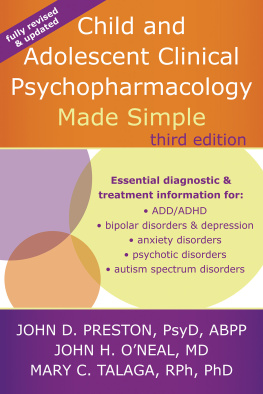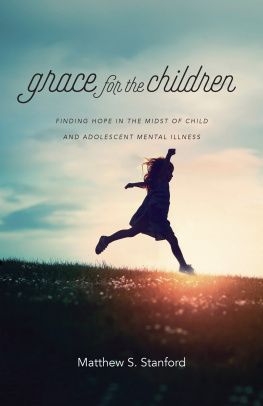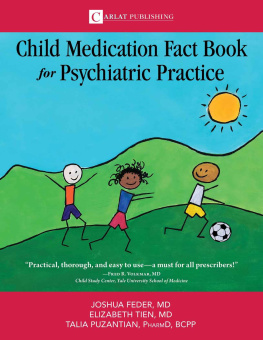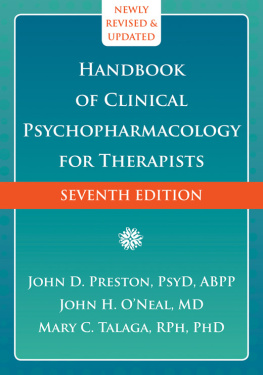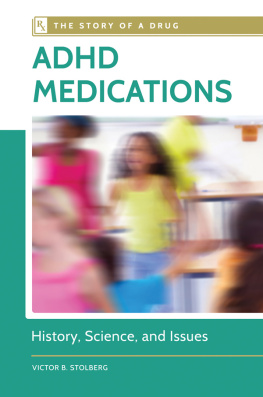
John D. Preston, PsyD, ABPP, is professor emeritus at Alliant International University in Sacramento, CA, and has also served on the faculty of the University of California, Davis, School of Medicine and the Professional School of Psychology, San Francisco. He has authored twenty-one books in the areas of psychotherapy, neurobiology, and psychopharmacology, and coauthored Clinical Psychopharmacology Made Ridiculously Simple, Consumers Guide to Psychiatric Drugs, and Handbook of Clinical Psychopharmacology for Therapists. Preston is a fellow of the American Psychological Association and has lectured internationally.
John H. ONeal, MD, is a board-certified psychiatrist in private practice for over twenty-five years and assistant clinical professor in the department of psychiatry at the University of California, Davis, School of Medicine. He is past chief of the Department of Psychiatry at Sutter Community Hospitals in Sacramento, CA. ONeal is a Distinguished Fellow of the American Psychiatric Association (APA), and lectures on depression and psychopharmacology to mental health professionals, self-help organizations, and the public. He is coauthor of Handbook of Clinical Psychopharmacology for Therapists.
Mary C. Talaga, RPh, PhD, has been a pharmacist for over thirty years, with specialization in psychiatric pharmacy and pharmacy administration. Talaga has practiced in a variety of clinical settings. She is coauthor of Handbook of Clinical Psychopharmacology for Therapists.
Child and Adolescent Psychopharmacology Made Simple is an outstanding contribution for the non-pharmacist health professional. The chapters are clear, practical, concise, and authored by pharmacists, physicians, and behavioral health experts with current knowledge and valuable insights for health professionals working in medical, dental, and behavioral health settings.
William Gordon, PhD, president of the Institute for Brain Potential
This is a great handbook that is up-to-date and very clearly written. The short chapters and multiple tables make it extremely easy to use. I find it ideal when I need quick access to information on the latest psychopharmaceuticals for kids.
Daniel Carlat, MD, associate clinical professor of psychiatry at Tufts University School of Medicine, and publisher of The Carlat Psychiatry Reporta

Publishers Note
This publication is designed to provide accurate and authoritative information in regard to the subject matter covered. It is sold with the understanding that the publisher is not engaged in rendering psychological, financial, legal, or other professional services. If expert assistance or counseling is needed, the services of a competent professional should be sought.
Chapter 9 of this text, Over-the-Counter Medications and Dietary Supplements, is adapted from CLINICAL PSYCHOPHARMACOLOGY MADE RIDICULOUSLY SIMPLE (8th ed.), by John D. Preston and James Johnson. Copyright 2014 John D. Preston and James Johnson. Used by permission of MedMaster, Inc.
Distributed in Canada by Raincoast Books
Copyright 2015 by John Preston, John H. ONeal, & Mary C. Talaga
New Harbinger Publications, Inc.
5674 Shattuck Avenue
Oakland, CA 94609
www.newharbinger.com
All Rights Reserved
Acquired by Melissa Kirk and Catharine Meyers; Cover design by Amy Shoup;
Edited by Kayla Sussell; Text design by Tracy Marie Carlson
Library of Congress Cataloging-in-Publication Data on file
To my grandsons, Atticus and Ender: identical and so unique!
JP
In memory of Patrick Everette Cummings.
Your spirit lives on.
MT
To my patients, for they have been my best teachers.
JO
Contents
Acknowledgments
Many thanks to our publisher, Dr. Matthew McKay, freelance copy editor Gretel Hakanson, and our most excellent editors, Melissa Kirk, Catharine Meyers, Karen ODonnell Stein, and Kayla Sussell.
Thanks to our families, with deep appreciation for their patience and encouragement.
Finally, a heartfelt thanks to our patients.
May this book help our fellow mental health clinicians in our shared and ongoing struggle to reduce emotional suffering in young people.
Introduction
Sharing Our Concerns: For Health Care Providers, Parents, and Patients
Facts without values, fragmentary specialties with no integrating philosophy of life as a whole, data with no ethical standards for their use, techniques with no convictions about lifes ultimate meaning here a panacea has turned out to be a problem.
Harry Emerson Fosdick The Living of These Days(1956)
Many young people experience considerable emotional suffering. Oftentimes this psychological pain is associated with poverty, poor prenatal care, racial or other forms of discrimination, serious family dysfunction, traumatic life events, or any of a host of neuropsychiatric disorders. Only certain types of emotional distress are appropriate for treatment with psychiatric medications.
Psychiatric medication treatment of children and teenagers began in the 1960s. Yet only recently have large-scale medication trials been conducted. The research in child psychiatry is still considered to be limited. Clearly advances have been made, both in the safety of medications and in the development of treatment guidelines. In this book we summarize basic information regarding classes of psychological disorders for which medications are often prescribed, and we present current guidelines for the use of medications. However, we first want to state three important and overarching concerns.
The first concern is that in the current era of managed care, it is common for insufficient time or attention to be given to conducting a comprehensive history and diagnostic evaluation. Such an evaluation is essential before any recommendation can be made regarding treatment. Second, it is clear that when psychiatric medications are used to treat particular disorders, close follow-up is warranted and essential for addressing problems of treatment adherence, managing side effects, and monitoring response to treatment. Third, most children and teenagers suffering from psychological problems do not require medication treatment; instead, they may need psychosocial interventions, often involving the family as well as the individual. Even in those conditions that are judged to be largely neurobiological in nature and responsive to medication treatments, psychotherapy is alwaysindicated.
In voicing these three issues, it may seem as if we are just stating the obvious; however, our concern is that with the quick-fix and get-on-with-your-life mentality in our social culture and the health care industrys focus on cost containment, the knee-jerk reaction of too many providers may be to reach for the prescription pad whenever they see psychological symptoms. While the appropriate use of psychiatric medications has helped many young people, we feel its important for us to strongly endorse a comprehensive approach to treatment. This approach should be based on careful evaluations, close monitoring, and the use of psychotherapy, with medications prescribed only if warranted.
It is also important for clinicians, consumers, and parents alike to be aware of the risks and benefits of all treatments. Because of the enormous complexity of human psychological functioning, most problems are multidimensional and require interventions on a number of levels. And it is equally important to be humble regarding our approaches to treatment. Psychiatric drugs, as we shall see in this volume, can reduce rates of suicide, may decrease the risk of substance abuse, and in some instances may prevent certain kinds of brain damage. But medical treatments also have clear limits; there are no panaceas. No drug can mend a broken heart, fill an empty life, or teach parents how to love their children.

